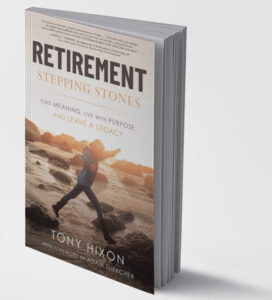Editor’s Note: Tony Hixon is the author of the new book, “Retirement Stepping Stones: Find Meaning, Live with Purpose, and Leave a Legacy.”
Sometimes, unexpected events have a lifelong impact not only on our day-to-day lives but also on the way we see the world and how we relate to others in our lives — family, friends, and those we do business with.
 I’ve been a financial planner and business owner since 2002, although entrepreneurship was never originally in my plan. In fact, when I grew up on a farm outside of Findlay, Ohio, all I knew was that I wanted to get out into the world and do something with numbers. Math had always been a strong suit of mine. I chose to attend Ohio Northern University, where I earned my bachelor’s degree in accounting. After graduating, I started work at a local accounting firm. I loved what I was doing, but I had a feeling that there was something more in store for me.
I’ve been a financial planner and business owner since 2002, although entrepreneurship was never originally in my plan. In fact, when I grew up on a farm outside of Findlay, Ohio, all I knew was that I wanted to get out into the world and do something with numbers. Math had always been a strong suit of mine. I chose to attend Ohio Northern University, where I earned my bachelor’s degree in accounting. After graduating, I started work at a local accounting firm. I loved what I was doing, but I had a feeling that there was something more in store for me.
As passionate as I was about technical financial work (I still am a numbers guy, after all), I was frustrated to see how many people struggled to live comfortably throughout their retirement. The majority of my accounting firm clients had the means to live any lifestyle they wanted, but through a lack of planning, they were struggling. They owed more in taxes than they wanted to and were unable to check off all their bucket-list items during the exact time of their lives when living happily should have been a priority!
I also felt an immense frustration that the clients I were helping were essentially project based. By that, I mean that I’d see them annually during tax season, then they’d disappear until the following year. I consider tax planning a critical component of a comprehensive financial strategy, not a time-to-time activity. Still, I felt like I was helping clients create Band-Aid solutions retroactively to account for past financial mistakes. I wanted to help clients become proactive about their money and empower them to live lives they were proud of, and I was ready to do that.
In 2002 my business partner, Adam Zuercher, and I decided to launch Hixon Zuercher Capital Management. We had originally met back in high school. Of course, as two teenage kids growing up in a small town outside of Findlay, Ohio, we never had imagined we’d be setting out to launch a business together years later. We were both passionate about financial planning and helping our clients reach their goals and retire with confidence. As a self-proclaimed numbers guy, I was eager to give our clients a technical overview of their strategy. We had software that could create long, detailed reports, and I’ll admit that I found solace in the certainty that numbers provided. My goal was to help our clients ensure that they wouldn’t outlive their money — and possibly even have enough to accomplish some of those bucket-list goals.
However, after several years of doing business with only numbers as my criteria for client success, a family crisis changed my thinking and how I now counsel clients to think about their lives and plan for the future.
My mom, Pam Hixon, came to me when she turned 60. She was eager to retire but wanted to know if she could financially pull it off. I took some time to crunch the numbers for her. She had enough saved to live comfortably, and so I gave her the go-ahead.
She retired almost as soon as I gave her the green light in 2010. What happened next changed my life and the direction of my career.
Previously, when working with clients, I had seen only the rosy side of retirement. These folks were excited to enter the next chapter of their lives and had a clear idea about how they wanted to spend their time as retirees. I believe my mom was the first person I spoke to who actually felt unsettled by the idea of leaving her career. She wasn’t sure what the next chapter looked like, and she wasn’t particularly open to putting a plan together for both her finances and her lifestyle.
But now I know exactly how necessary that is for pre-retirees. These days our wealth management firm focuses on the quantitative financial data and the softer, nonfinancial side of retirement when meeting with our clients. We talk to them seriously about the possibility that, when they retire, they may feel lost.
It’s a sad truth that your chance of suffering from depression goes up by close to 40% after you retire, and approximately 25% of adults over age 65 are experiencing some form of mental-health issue. The worst part is that very few people openly discuss this increasingly problematic issue. Retirement is still painted as 20-plus years of vacation. As a result, retirees are underprepared to face their retirement in an empowered way that allows them to live into their purpose.
My Mother’s Story
To understand what happened to my mother, you should know something of her life.
Born on April 11, 1949, in Bluffton, Ohio, Pamela May Frantz graduated from Pandora Gilboa High School and ended up marrying her high school sweetheart, J. Robert Hixon. In 1971 she graduated from college and completed the requirements to become a registered nurse.
From there, she went to work at a nearby hospital. She loved caring for others, and that attitude was felt most by my sister and me. Mom worked hard but soon found that the hours and shifts no longer accommodated her family. When she was offered a home-health nursing job, she was able to be home earlier so she could be there when my sister and I got home from school. The hours were more regular, and as the years progressed, she was able to get another home-health job closer to home, which ultimately led to her interest in hospice nursing.
Mom had been promoted at her hospice agency and eventually became the director. It was there that she found fulfillment. It was there that she found her source of strength.
It was there that she achieved the most epic case of burnout I’ve ever seen.
As a hospice nurse, Mom had worked long and hard hours for years, comforting those who, like it or not, had come to a point where they were forced to make peace with death. She would build relationships not only with the patient but also with the family members who stood by as the patient transitioned from this life to the next.
As family and friends grieved, Mom would show love and support and then move on to the next case. Hour after hour, year after year, the work took a toll on her emotionally, physically, and spiritually. She was done. She wanted — no —she needed to retire.
“She was anxious to retire and get out of there,” Dad remembers. “They were being forced to computerize, and she didn’t love it.” The more tech-focused hospice care became, the more my mom found herself behind a computer screen instead of with the patients she cared about.
Mom and Dad had always used another advisor for most of their financial dealings. I felt this was appropriate because we were family, and often family and business don’t mix. However, Mom asked me to run some numbers to see if she and Dad would be able to retire soon.
She and Dad were excited at the prospect of running my dad’s small farm together. They talked about going camping and living a life they loved during retirement. I sprang into action and whipped my software into shape. The numbers revealed that if they kept a tight control on expenses, Dad continued to work at the factory for a few more years and then continued to farm, they would be fine.
Affirming what their other advisor had said, I, too, gave them the green light. And that was that. In the fall of 2010 Mom retired.
Losing Purpose and Hope
For most people, retirement is a time for celebration. A time for exploring, recuperating, and recovering from a career. My mom, though, found herself on Monday morning not quite knowing what to do. She truly had a servant’s heart, and when her primary outlet to serve and help others was taken away, she was more than a little lost. She had been so consumed with work that she didn’t have many hobbies or outside interests. My dad continued to work, so for long periods of time during the day she was alone. Her friends were also still employed and were not as available as she had hoped.
Fall turned into winter. The grass withered, and the colorful leaves of autumn fell from the trees as nature prepared for a cold season. Sunlight became scarce as clouds filled the sky. Day after day, Mom simply did not have much to do.
She began to lose purpose and then to lose hope. And in a short amount of time, she began to spiral into a deep depression. Dad noticed a shift in Mom’s mood. Anxiety seemed to bubble up inside of her in a way it never had before.
“This,” of course, was her transition to retirement. Both my dad and my sister commented on her incessant pacing back and forth. Dad also recalled her sitting in a rocking chair, rocking back and forth obsessively while she worried about money (something that had never before concerned her).
Still, we all assumed that the retirement transition would eventually smooth out.
Over the next several months, she didn’t keep quiet about her feelings. She spoke with a counselor, with friends, family, and mentors, and she tried to fill her time with activities she loved. She picked up meditation, focused on prayer, and spent more time with her loved ones. Still, she couldn’t shake the feeling of not being needed anymore. After a long and fulfilling career in which she had been an integral part of people’s lives, she felt like she no longer brought any value to the world or to the lives of those around her.
The winter was rough. Snow flew, the wind blew, the sun hid, and her depression and anxiety became worse than it had been when she still held her job at the hospice agency.
We knew she wasn’t doing well mentally. At the same time, we didn’t know how deep the depression truly was.
As a nurse, she had been there to see that the patient was as comfortable and as much at peace as possible. In the moments before the patient’s death, my mom would often be present in the room. She saw patients embrace the fact that their time on earth was fleeting, and she watched them ready themselves for what was next.
But Mom was anything but peaceful. Her prayers didn’t seem to be working, and her counselors couldn’t understand what she was feeling. She had nowhere to turn. She thought she had made an epic mistake by retiring. That choice was now her biggest regret. While most retirees enjoy their retirement, she detested the empty hours. Try as she might — with prayer, counseling, songs, sermons, and books — her anxiety snowballed, and her depression deepened.
When she could no longer stand the emotions that tore at her mind and heart, she felt she had only one option. Her desire for peace of mind became misguidedly intertwined with the peace that she had seen in her patients as they left this world. Ingesting too many sleeping pills, she took the final journey toward the peace she so desired.
Conversations Changed
The ripple effect through my family and my mom’s close-knit community has been profound. As much as her death impacted us, though, it also left us with a deep desire to improve ourselves and our own lives.
As for me personally, I was determined to turn this tragedy — this stumbling block — into a stepping-stone in my life and my career.
After my mom passed away, the approach I took with my financial-planning practice completely changed.
Previously, I had “industry blinders” on. Most of the clients who sat across the desk from me were eager to retire. Retirement was the goal, the perfect finish line. The majority of people I spoke with already had big plans to travel, to spend more time with their grandkids, and to enjoy their hobbies.
After talking with them, I was able to punch numbers into our financial-planning software, print out a 32-page document, and confirm whether or not a client was financially ready for retirement. That document and presentation looked good, but after going through such a tragic experience with my family and my loved ones, I realized the financial-planning process didn’t go deep enough into what pre-retirees needed to consider in order to determine whether they were truly “ready” to retire.
I started implementing a new approach to my conversations with clients.
Before we even talk about the financial possibility of retirement, we now dive into a much more personal conversation with our clients. This qualitative side of retirement planning has often been overlooked in the financial-planning profession.
I’ve been working in the business for a long time, and I can honestly say that only in the past two or three years have nonfinancial conversations about retirement readiness been openly discussed among my colleagues in the industry.
Too often, pre-retirees work for 30-plus years building a career, sometimes in a single industry, then walk away without looking back when they retire. What they don’t realize is that they’ve spent more than three decades building much more than a career. They’ve been:
• Organizing a routine that’s comfortable and familiar.
• Honing skills and capabilities.
• Forming lifelong relationships with close friends.
• Building a social network for events and after-work connection.
• Creating a purpose-driven life.
The day that they wake up as a retiree is often the day that they walk away from many of those fundamentals. In other words, their career has played a major role in creating their identity. In hindsight, this played a large role in my mom’s depression and, ultimately, contributed to her passing away.
This is why, in my own life and my business, I’ve started exploring the nonfinancial side of retirement.
When working with clients, we ask a lot of uncomfortable questions that they may not have previously considered. For example:
• What skills do you possess?
• What do you love about your career?
• How are you going to find that same joy, or use those skills, when you retire?
• How can you live a life of purpose in retirement?
• What are your plans as a retiree? How do you plan to spend an average Tuesday?
Life in Two Halves
In my own life, I often reread the book “Halftime: Moving from Success to Significance” by Bob P. Buford. Some of the topics he covers about viewing retirement as the “halftime” in your own life truly resonate with me.
The primary point Buford makes is that life is, essentially, divided into two halves. Retirement shouldn’t be a finish line. Instead, it should just be another chapter in your life that you approach with the same dedication and planning you did your career. However, before you can pursue the second half of your life, you need to take a break. Just as there’s a halftime show at the Super Bowl, retirees need their own halftime before pursuing whatever is next for them in their path to fulfillment.
Buford recommends taking time to fully decompress. That allows you, he says, to make space for the critical thinking and inspiration required to find the right next steps for you personally.
We encourage all of our clients to take and embrace this halftime. Too often, when retirees jump into the “next thing” the second they leave their careers behind, they find themselves continuing a pattern of burnout.
It’s easy to remain unfulfilled when you don’t give yourself the breathing room you need to stop, enjoy your day-to-day, and create a clear break between the first and second halves of your life.
The truth is, you’ve worked hard for your retirement. You deserve to enjoy it. Someday, when I retire, I want to love every minute of it. You have every right to rest, relax, travel, and check items off your bucket list. But when the initial excitement of retirement wears off, you also deserve to enjoy a purpose-filled life every day.
You owe it to yourself to continue asking questions about whether you’re fulfilled and whether you feel good as a retiree. Be open to the realization that goalposts can move. You may feel less fulfilled in Year 5 of your retirement than you did in Year 1, and that’s okay.
You’re allowed to pivot and explore new lifestyle options for yourself.
I know that my mom would be proud if she knew her story could positively impact others. She was a giving person, and part of her legacy will be helping other retirees navigate the retirement transition and find joy in this new phase of their lives.
Tony Hixon is co-founder, chief operating officer and chief compliance officer of Hixon Zuercher Capital Management in Findlay, Ohio. This article for Rethinking65 is based on chapters in the book and is printed with permission.







